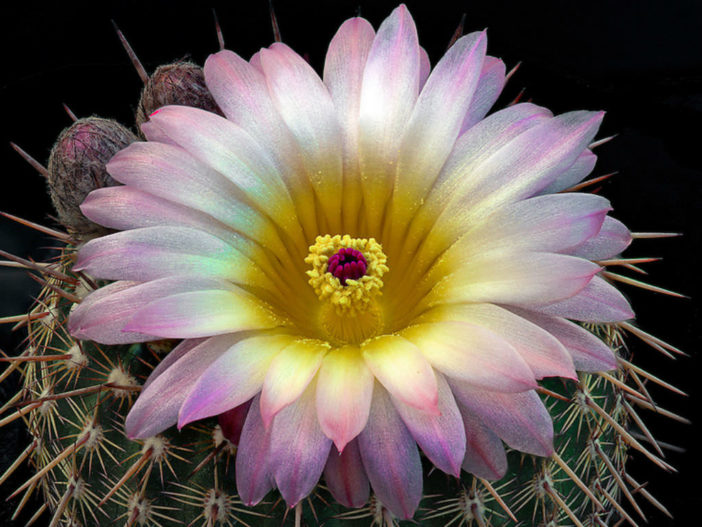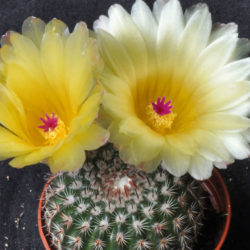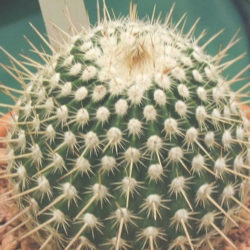Scientific Name
Parodia mueller-melchersii (Backeb.) N.P.Taylor
Synonym(s)
Notocactus mueller-melchersii, Notocactus mueller-moelleri, Ritterocactus mueller-melchersii
Scientific Classification
Family: Cactaceae
Subfamily: Cactoideae
Tribe: Notocacteae
Genus: Parodia
Description
Parodia mueller-melchersii, formerly known as Notocactus mueller-melchersii, is a small cactus with a globose to short cylindrical, usually solitary stem with 18 to 24 slightly tuberculate ribs lined with distinct areoles bearing clusters of spines. The stem can grow up to 9.6 inches (24 cm) tall and 2.4 inches (6 cm) in diameter. Each areole bears 1 to 3 central and 12 to 18 radial spines. The central spines are yellowish, light brown, reddish-brown, or dark red with dark spots and up to 0.8 inches (2 cm) long, while the radial spines are pale yellow or whitish, with darker tips and up to 0.3 inches (8 mm) long.
The flowers are creamy yellow, pink, light lavender, or reddish, measure up to 1.6 inches (4 cm) long and 2.4 inches (6 cm) in diameter, and appear near the stem tip in summer. The fruits are pale brown, club-shaped with a dry pericarp, and up to 0.6 inches (1.5 cm) long.
Origin
Parodia mueller-melchersii is native to Brazil (Rio Grande do Sul) and Uruguay (Artigas, Paisandú, Rivera, Salto, Tacuarembó, and Maldonado). It grows in pampa grasslands with rocky outcrops at elevations from 490 to 985 feet (150 to 300 m).

Hardiness
USDA hardiness zone 9b to 11b: from 25 °F (−3.9 °C) to 50 °F (+10 °C).
How to Grow and Care
If you can grow cacti and succulents successfully, you can likely grow the popular Parodias without too much trouble. However, it's key to remember that Parodias don't like direct sunlight and are accustomed to more even water than many other cacti species. The cactus mustn't be exposed to prolonged dampness and sitting water. Never let your cactus sit in a dish of water. To encourage better flowering, allow the plants to enjoy a cooling period in the winter and dramatically cut back watering. However, unlike other cacti species, you don't need to stop watering entirely. Lastly, ensure to fertilize during the growing season for the best results.
Repot as needed, preferably during the warm season. To repot a cactus, ensure the soil is dry before repotting, then gently remove the pot. Knock away the old soil from the roots, removing any rotted or dead roots. Treat any cuts with a fungicide. Place the plant in its new pot and backfill it with potting soil, spreading the roots out as you repot.
See more at How to Grow and Care for Parodia.
Links
- Back to genus Parodia
- Succupedia: Browse succulents by Scientific Name, Common Name, Genus, Family, USDA Hardiness Zone, Origin, or cacti by Genus
Photo Gallery
Click on a photo to see a larger version.


